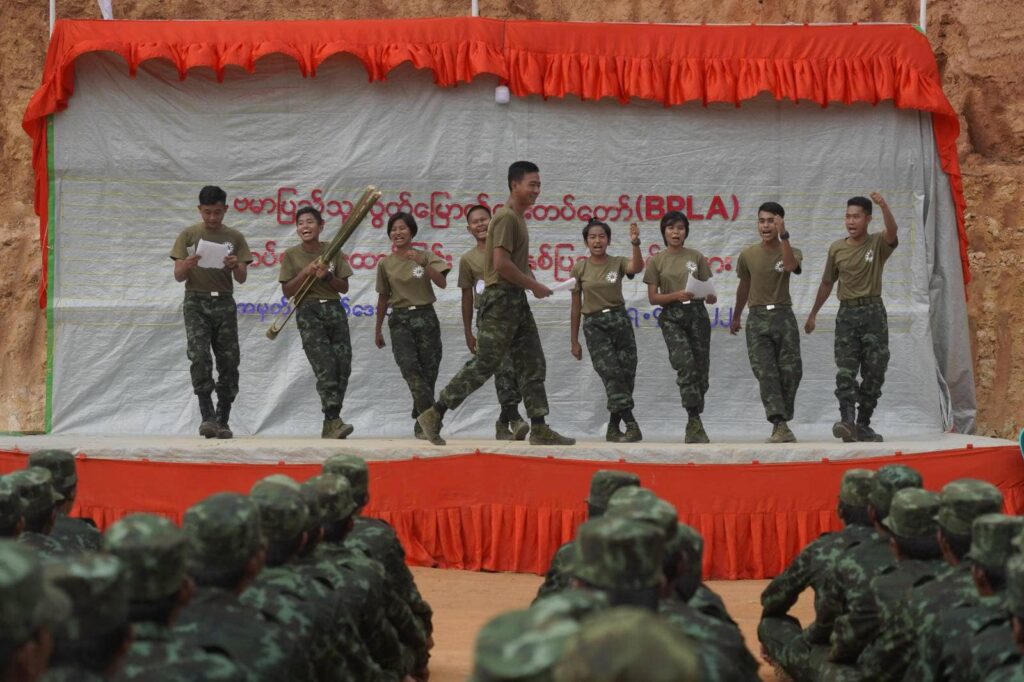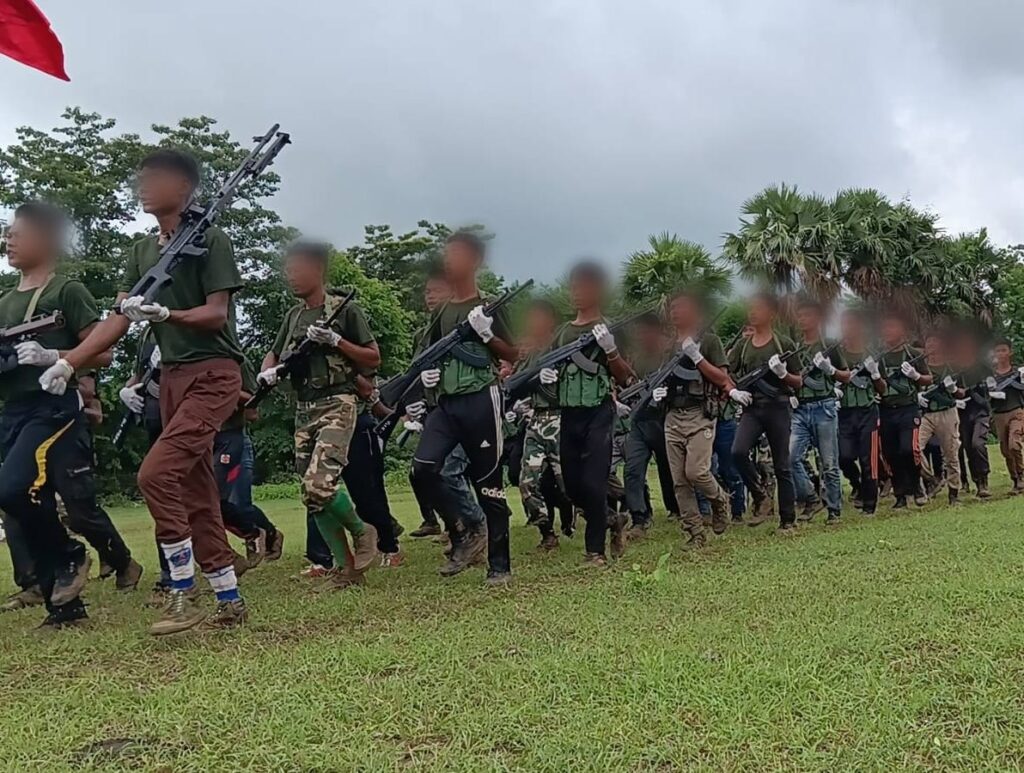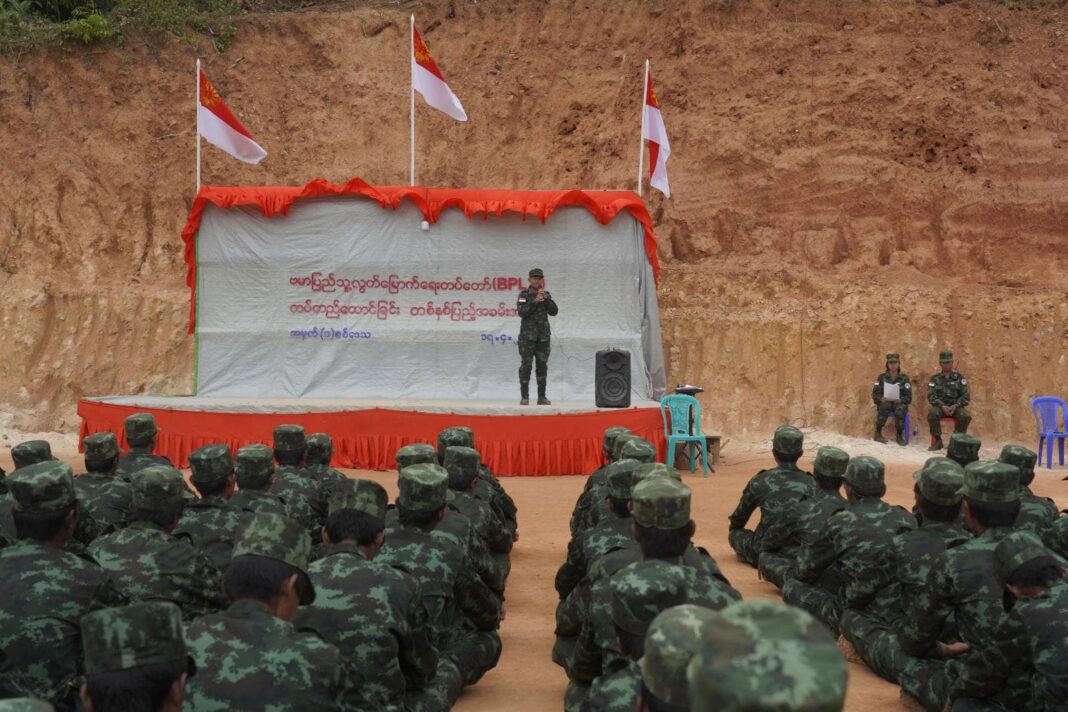It is really delightful and satisfying to witness the emergence of a new generation of youthful Bamar leaders, who are sophisticated, earnest, sincere and able from the ruins of Maha Bamar racial supremacy doctrine that have plagued the country for decades, both under the successive civilian and military regimes dominated by the Bamar political elite and military classes ever since the independence from the British in 1948.
The two most outstanding figures in this respect is the Bamar People Liberation Army (BPLA) leader Maung Saung Kha and newly formed Burma National Revolutionary Army (BNRA) chief Bo Naga, who has made a name for himself as a now disbanded leader of the Myanmar Royal Dragon Army (MRDA) in Pale Township of Sagaing Division.
No doubt, there may be many more such young Bamar leaders lurking behind the revolutionary scene gearing to emerge anytime soon. But let us look at the two first.
BPLA and Maung Saung Kha
The Bamar People’s Liberation Army (BPLA) is a Bamar ethnic armed organization (EAO) or ethnic revolutionary organization (ERO) founded by Maung Saung Kha, a prominent Burmese poet and human rights activist, together with like-minded 16 others in April 2021, after the February military coup the same year. He participated in the protest against military coup until he left for underground in Karen State two months later as peaceful demonstration were brutally crushed by the military junta, which called itself State Administration Council (SAC).

BPLA was formed on April 17, 2021 in Karen State, Karen National Liberation Army (KNLA) Brigade 5 area with the help of KNLA, armed wing of the Karen National Union (KNU). It is now believed to field a thousand of disciplined fighters and has been actively participating in KNLA Brigade 5 area, together with the KNLA and National Unity Government (NUG)/People’s Defense Force (PDF) against the military junta. It also is operating in northern Shan State, under the Kokang or Myanmar National Democratic Alliance Army (MNDAA). Besides, it is being supported by the Arakan Army (AA). Its aim is to penetrate back to Bamar populated area after it has gathered enough military experiences in the ethnic states.
In August 4, he again confirmed to Reuters that his organization is seeking a foothold in Bamar-dominated area, known as Anya or Dry Belt geographically.
“Maung Saungkha said the move is a key strategic aim for his Bamar People’s Liberation Army (BPLA) – a militia formed in the wake of the junta’s February 2021 coup – now that it has gained training from allies and battle experience in the country’s borderlands. Most BPLA members are Buddhist Bamars, the ethnic group that accounts for two-thirds of the population and dominates central Myanmar where government institutions are based.”
“For an army formed from Bamar people, it’s an important part of our vision to be based in a Bamar region and to be active there,” the 30-year-old commander said via text from his jungle camp near the border with Thailand, according to Reuters.
According to Maung Saung Kha, the BPLA objectives are:
- to end the dominance of Bamar Buddhists over other ethnic groups and to strengthen the unity of Myanmar’s diverse ethnic groups under a federal democratic union.
- to ensure that, if Aung San Suu Kyi is released from house arrest, no political compromises are made under the name of state stability, according to the The Guardian report of February 9, 2022.
Moreover, Maung Saung Kha wrote in his Twitter post of January 28, 2022 : “The Bamar People’s Liberation Army, seeks to uproot dictatorship and chauvinism, strengthen ethnic unity, recognize a Bamar state or constituent unit based on Bamar identity in a future federal union.”
On its website the BPLA political goals are stated as follows:
- The downfall of the dictatorship and the liberation of all the people from oppressive rule
- An end to racial supremacy doctrine and achievement of equality and self-determination
- Building a new federal state that guarantees democracy and human rights
- In the construction of a new federal union, the inclusion of the Bamar Federal Unit (or) Bamar State as the Union member and
- Protecting the freedom and safety of the public.
Remarkably, in an interview with Federal FM on April 12, 2023 he said regarding the Bamar State creation: “Because the Bamar State issue concerned not only the Bamar it also involved the union. If we aim at all-inclusive union, which is really harmonious, equal, self-governance guarantee federal system, Bamar State issue must be considered and we should begin talking about it.”
He even went further saying: “Some said the Bamar State issue should be handled only by the Bamar and non-Bamar should not be involved is not appropriate. We don’t see it that way because this is the union issue. We think this is extremely narrow-minded to exclude the non-Bamar inputs.”
BNRA and Bo Naga
On September 9, 2023, BNRA spearheaded by Bo Naga leader of the Myanmar Royal Dragon Army (MRDA) was formed with 18 battalions earmarked from Local People’s Defense Armies. Reportedly, MRDA was also disbanded on the same day to be part of the new setup.

A row between the NUG’s Ministry of Defense (MOD) and Bo Naga erupted when the former dismissed the four PDF battalions, which originally were from MRDA and it had given them to be under the MOD a few months ago.
According to Bo Naga the MOD said in order to have a clear chain of command the four PDF battalions were given back to the MRDA, including the termination of funds and other assistance. Bo Naga readily accepted it back into the MRDA fold, but within a few days the said four battalion commanders signed a petition and asked the MOD directly to receive them back, which it did without consultation with Bo Naga. Now a little more than two from the four battalions have rejoined the newly formed BNRA which may be stronger than the planned 18 battalions, according to an introduction message of Bo Naga following the BNRA foundation.
Other than that the NUG office also issued a statement rejecting the misunderstanding that Bo Naga has a green light from the the NUG following the foundation of the BNRA on September 9, as it has no function or agreement for its establishment and that the zoom meeting between Bo Naga and NUG president, including minister of defense, only talked about the Chain of Command (COC).
On September 12, the NUG Office issued a four-point statement which said that Acting NUG President Duwa Lashi La and Defense Minister U Yee Mon met Bo Naga via zoom meeting on May 2, 2023. The main topics were to encourage participation in the COC established by the Ministry of Defense and revolutionary allies according to military regions and to accept and participate in the security sector reform programs in post-revolutionary period.
The fourth point closing stated: “This was the full extent of the discussion. The Acting President and Union Minister U Yee Mon raised no further issues nor made any agreements.”
In its foundation statement on September 9, it writes: “Aspiring sincerely to the pressing political exigencies of our nation’s tumultuous era as demanded by and in the interest of the people of Myanmar and in recognition of the ongoing Myanmar Spring Revolution, we solemnly declare the formation of the Burma National Revolutionary Army (BNRA).”
“BNRA’s resolute objectives are as follows:
- To forge a federal democratic union that guarantees equal rights for all ethnic peoples.
- To craft a political doctrine founded upon the pillars of freedom, justice, equality and lasting peace.
- To eradicate and end permanently all forms of dictatorship and ensure the safety of the people of Myanmar by collaborating closely with the National Unity Government (NUG), local revolutionary forces such as LPDFs and PDFs and the entirety of Ethnic Revolutionary Organizations – EROs.
- To secure the right to self-determination for the Anya region, including Sagaing, and achieve self-determination for all ethnic peoples across Myanmar.
Guided by these steadfast policy objectives we shall ardently pursue our mission,” according to the statement.
In Bo Naga’s clarification or introduction on September 9 following the BNRA formation he emphasized the following points:
- not forming a separate organization but to work under the NUG and stand tall on the side of the people;
- have discussed personally with NUG President Duwa Lashi La and Minister of Defense U Yee Mon regarding the BNRA foundation;
- to build people’s defense army with political awareness and military capability;
- to build an army that obey two COCs, which are military Code of Conduct and Chain of Command;
- to gather groups which are unable to join the NUG’s Ministry of Defense for whatever reason and to systematically build the military capability, political awareness, adhering to the COC into a Bamar revolutionary army;
- BNRA earmarked 18 battalions from Sagaing, Magwe and Mandalay division for the formation, now as a little more than 2 battalions under the MOD have rejoined the fold;
- the using of “Bamar” etiquette in BNRA* is to repay the historical debt by joining the other ethnic groups’ struggle for rights of self-determination, equality, and liberty as a Bamar group; (*although “Burma” is used in English spelling, in Burmese “Bamar” is used.)
- will fight hand-in-hand with all like-minded armed organizations and political parties to achieve the political guarantee of ethnic, individual, regional, rights based on federal democratic union; and
- the struggle is not to achieve power for any individual, organization, or just a liberated area for our organization but for the liberation of the whole country and all ethnic groups, to achieve real peace and freedom.
Perspectives and outlook
Looking at the political stance of the two leaders, the BPLA Maung Saung Kha and BNRA Bo Naga, it could be summed up that they almost have the same outlook.
The projected goals of the two leaders on establishment of federal democratic union, Bamar State creation, anti-Bamar supremacy stance, achieving ethnic equality, democracy, rights of self-determination, and universal human rights are all identical.
The only difference is the BNRA is fighting in its Bamar home front in Anyar already, while the BPLA is engaged in Karen and Shan states together with the other EROs. But the latter is gearing to penetrate back into Anya region the heartland of the Bamar, as it has already gained enough combat experiences fighting together with the EROs in ethnic states.
The BNRA has a bumpy relation with the NUG, maybe due to the Bo Naga outspokenness on the issues of Bamar State creation; pronounced anti-dictatorship of all kinds and not just anti-military dictatorship; and pushing the NUG to draft a transitional constitution as soon as possible and not just going with the unfinished Federal Charter. All these don’t seem to go down well with the NUG leadership, that may have led to the frosty relation and eventually cutting financial aid and dismissing the four PDF battalions formerly under the Bo Naga’s MRNA.
Moreover, the NUG refusal to endorse the newly formed BNRA may also stem from the said frosty relationship that has happened quite recently within the last few weeks, even though BNRA recognized the NUG as its government and proposed to work together.
On the other hand, the BPLA led by Maung Saung Kha enjoyed good relationship with the NUG and even received various assistance from it. BPLA fought with the KNLA and NUG’s armed wing PDF in Karen State also. Maung Saung Kha is believed to be arranging to enter Anyar region with the help of NUG, so that it has a foothold in Bamar populated areas, according to the media reports.
The NUG actually is more or less on the same page, except for implementation of so-called “three Pa” in Burmese or “three P” in English, which denotes, people’s administrative, people’s defense and people’s police or security teams, that has become problematic for continuation frictions and clashes among the NUG’s own apparatus on the ground, not to mention the local resistance forces that are not under the NUG. These developments confused the population in Anya region and also tarnish the NUG’s image to a certain extend.
In closing, NUG is well advised to wisely cooperate and coordinate with the soft spoken but determined leader Maung Saung Kha of BPLA and also with the out spoken but blunt and equally committed leader Bo Naga of BNRA. In other words, the NUG’s cordial relationship with Maung Saung Kha should also be extended to Bo Naga, as both almost share the same political outlook and are really fighting in the field.
Moreover, the building of understanding and solidarity will be more beneficial to all parties concerned than confrontation, unconstructive criticism and argument leading to more divisiveness in tackling the row between the NUG and Bo Naga.
Other than that, it should work together with the community and military leaders on the ground in Anya region and not replacing them in top-down manner with the NUG appointed personnel who have no experience, feeling or understanding of the people and situation on the ground.
Last but not least, the NUG should make use of the God-given assets and not disregard them maybe just because of either personal rivalry or cannot tolerate the “holier than thou” paternalistic attitude. The NUG should be pragmatic and embrace the motto of “It doesn’t matter whether a cat is white or black, as long as it catches mice.”
A seasoned Burma watcher told this writer when asked on how he assess the present row among the Bamar as follows: “Just be one of the boys in the team if you want to win. Insist on being top dog if you don’t want to.”
The suggestion seems to go both ways.




